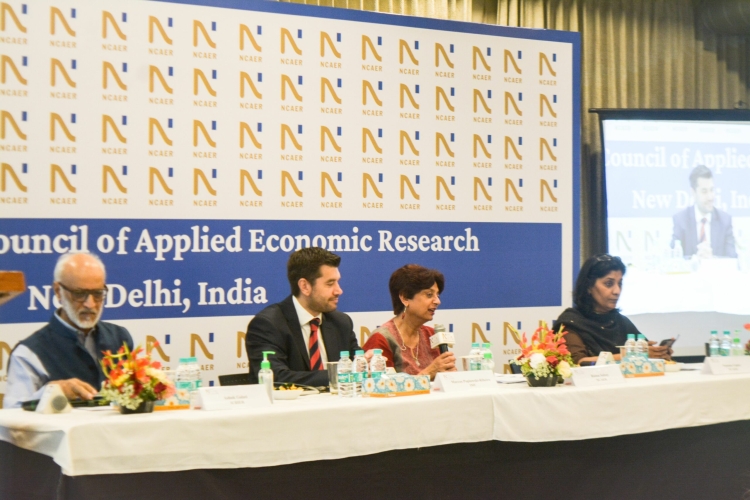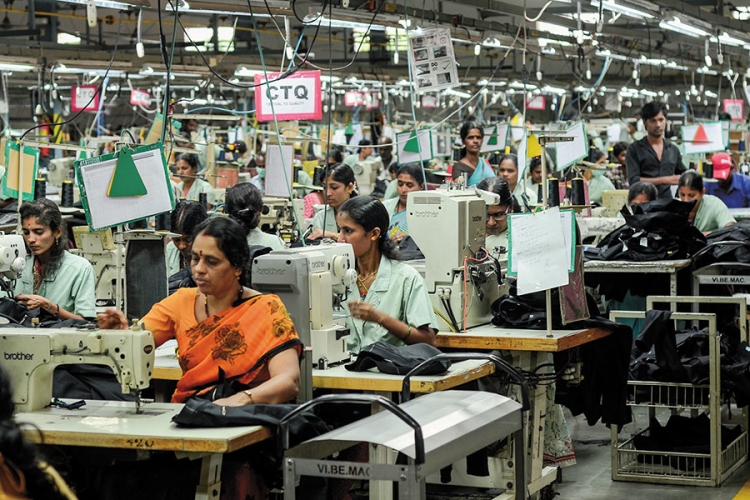5 small and midcap real- estate stocks with upside potential of up to 34%: There are some sectors where when the tide changes for good, all companies in that sector enjoy the tailwinds. Yes, when it comes to the stock market, it is the large players from the sector which tend to get noticed first but the fact is when things improve, especially when it comes to demand, all the players benefit from rising demand. In the last four years, the demand for real estate has seen a sharp rise. Beside the large well known name, even the small and midcap companies have seen the rising demand. Now in the case of real estate, the reason for a company being small or mid could be the fact that it is focussed on a region only. But that does mean that the company's profitability is lower. There are cases where the mid-sized region focussed company has better margins than a large one. After a phase of strong liking and getting thrown into dumps, comes a phase a move toward normal valuations. But only select companies participate in this process. While they will not get the same price earning multiples, but in absolute terms returns which are more sustainable is the question and the answer is probably, yes. Let's look how things have shaped up in the real estate industry in the last few years. Real Estate stocks - Upside potential Company Name Latest Avg Score Reco Analyst Count Upside Potential % Arvind 3 Strong Buy 1 56.6 Smartspaces Max Estates 5 Buy 1 39.4 Sunteck Realty 1 Strong Buy 11 34.8 Kolte-Patil Developers 4 Strong Buy 4 34.6 Mahindra Lifespace Developers 4 Buy 6 15.4 source:et
5 midcap stocks with upside potential of up to 36%: There is nothing wrong in being bullish all the time for one simple reason. As the Indian economy grows at a faster rate, the earnings of companies across different sectors and segments will grow faster and what drives the stock prices finally is the earnings. But yes, given the fact that valuations are high, one needs to be more selective in buying the stocks, because the downward movements like the one which happened in March will keep happening at periodic intervals. So, while being bullish one has to reduce the probability of making a mistake and reducing the risk of decline in capital invested in the market. In reducing market risks, investors should integrate both quantitative and qualitative criteria to assess stocks, aligning expectations with realistic market performances and avoiding impulsive shifts based on short-term fluctuations. More importantly at this point of time having one thing an investor needs to manage is his expectation that my stocks should give me return in the short term only and if it does not you jump from one ship to another. Look at companies with a certain level of ROE and ROCE. As the economy grows at a much faster rate there would be companies which will go in for expansions. For a business to expand it is extremely important that they should have a certain level of return in existing business so that when expansion takes place, the short term dip in return on capital does not dent the overall return on ROE and ROCE. Both these ratios not only financial ratios but also to some extent show the ability of the management in handling the cycles which any business has to deal with. We look at 5 mid cap stocks which had their latest average SR+ score improve by at least 1 point month on month, had a positive Upside Potential and a rating of "Strong Buy" or "Buy" or a "Hold". Mid Cap Stocks with Score Improvement Month on Month Upside Potential - Apr 9, 2024 Avg Score 1M ago Latest Avg Score Company Name Reco Analyst Count Upside Potential %▼ Inst Stake % 1Wk Returns % 3M Returns % 1Y Returns % Market Cap Rs Cr Arvind Ltd Strong Buy 10 9 7 69.1 23.0 8.2 15.3 230.4 7,760 CMS Info Systems Strong Buy 10 9 5 36.2 43.0 1.9 4.6 38.8 6,448 Home First Finance Co 5 4 Buy 17 31.4 27.6 3.4 1.6 34.9 8,431 Rallis India 8 7 Hold 16 17.8 20.6 6.0 4.5 35.0 5,277 Mahindra Lifespace Developers 4 3 Buy 7 17.4 34.4 3.7 13.2 74.7 9,969 Calculated from highest price target given by analysts source: et
Are high interest rates preventing India from replicating China's double-digit growth: Reforms like GST rollout and digitalisation were estimated to add another 2% to the GDP. But that has not happened. Capacity utilisation levels are below 75%, while private consumption growth has been slowest. Experts feel lowering interest rates may help. Is India punching below its weight? In the 2014-15 Economic Survey, the then chief economic adviser Arvind Subramanian wrote, "Facts and fortune have aligned in India's favour" to propel the country onto a double-digit medium-term growth trajectory. Subramanian argued that India was in a sweet spot, rare in the history of nations, wherein a historic political mandate coupled with stable external environment will lead to sustained reform push. It was seen as natural for a large enterprising economy like India to follow China's path of multi-decade double-digit growth. Reforms like the Goods and Services Tax (GST), once stabilised, were estimated to add nearly 2% extra to GDP (Gross Domestic Product) growth. Digitalisation of the financial sector was an icing on the cake. The National Council of Applied Economic Research (NCAER) had in a 2014 report estimated an increase of 0.9%-1.7% in GDP after full implementation of the GST. A March 2017 paper by researchers at the US Federal Reserve had projected the GST rollout to result in a positive impact on real GDP of up to 4.2%. Former bureaucrat Vijay Kelkar had estimated GST to ad 2%-2.5% to GDP. Private consumption is stagnant for the past 10 years. Even corporates are not building capacities. However, on lower capacities, they have seen high increase in sales - especially in high-end cars, air conditioners and real estate. But this demand is limited to the top 5 crore people. Despite all growth levers in favour, India is not growing at its best possible rate. But expectations are high. In fact, large corporates are seeing high asset turnover ratios closer to 2.17x for 2023 as compared to 1.69x in 2019. This looks like an improvement in demand for corporates to add additional capacities, but we need to wait and see. All arrows point towards high interest rate in India which is hampering growth. There are policy experts who believe that can be brought down from 6% to 4%, thereby kickstarting demand. source:et
Are high interest rates preventing India from replicating China's double-digit growth? Reforms like GST rollout and digitalisation were estimated to add another 2% to the GDP. But that has not happened. Capacity utilisation levels are below 75%, while private consumption growth has been slowest. Experts feel lowering interest rates may help. Is India punching below its weight? In the 2014-15 Economic Survey, the then chief economic adviser Arvind Subramanian wrote, "Facts and fortune have aligned in India's favour" to propel the country onto a double-digit medium-term growth trajectory. Subramanian argued that India was in a sweet spot, rare in the history of nations, wherein a historic political mandate coupled with stable external environment will lead to sustained reform push. It was seen as natural for a large enterprising economy like India to follow China's path of multi-decade double-digit growth. Reforms like the Goods and Services Tax (GST), once stabilised, were estimated to add nearly 2% extra to GDP (Gross Domestic Product) growth Digitalisation of the financial sector was an icing on the cake. While everything is aligned for India to grow, the fact is Indians are simply not consuming to the extent the economy demands. Some believe it is the high interest rates, others point out to high GST, while a few say there are just not enough jobs to buy things. Private consumption is stagnant for the past 10 years. Even corporates are not building capacities. However, on lower capacities, they have seen high increase in sales - especially in high-end cars, air conditioners and real estate. But this demand is limited to the top 5 crore people. Despite all growth levers in favour, India is not growing at its best possible rate. But expectations are high. In fact, large corporates are seeing high asset turnover ratios closer to 2.17x for 2023 as compared to 1.69x in 2019. This looks like an improvement in demand for corporates to add additional capacities, but we need to wait and see. All arrows point towards high interest rate in India which is hampering growth. There are policy experts who believe that can be brought down from 6% to 4%, thereby kickstarting demand. India is the fastest-growing large economy with fresh estimates pegging 2023-24 growth at 7.6%. A score of agencies including Moody's have bumped up their growth forecasts for the country. But key questions remain - is India punching below its weight? Have we narrowed ourselves into thinking that 7% is the potential growth? True, the world has seen several disruptions post pandemic. The fastest pace of monetary tightening by the US Fed starting 2022 was projected to topple the world economy into recession. But recession fears have come undone, as the US economy continues to cruise at a high-altitude growth and the International Monetary Fund projects global growth of 3.1% in 2024 and 3.2% in 2025. The UK and Japan - two of the G-7 countries - have slipped into recession recently, but their combined share in world GDP is below 5%. source: et
Weekly Top Picks: These stocks scored 10 on 10 on Stock Reports: Refinitiv, undertakes detailed company analysis for 4,000+ listed stocks. In addition to detailed company analysis, the report also collates analysts' forecasts and trend analysis for each component. To help you make best investment decisions, we have screened out all companies that have been awarded the highest score by Stock Reports Plus and clubbed it together with a 'Strong Buy/Buy' analysts' recommendation as per Institutional Brokers' Estimate System (IBES). Our weekly top picks can provide you actionable insights for companies with strong fundamentals. Each component is assigned a score on a scale of 1-10 (10 being awarded to the most favorable). Thereafter, an average score indicating the overall outlook of the stock is calculated by taking a simple average of the above-mentioned component ratings distributed normally. A score of 8 to 10 is considered positive, 4 to 7 is neutral and 1 to 3 given a negative outlook. Stocks with an average score of 10 with no recommendation from analysts are not included in this list. The scores are reevaluated every week wher all relevant data points in the report are updated daily. Here's a list of companies that have scored an average score of 10 as of February 25, 202 The list has been sorted on market capitalization. Companies with 10/10 average score and 'Strong Buy/Buy' recommendations from analysts Analysts' Mean Recommendation Strong Buy/Buy Count Hold Count Company Name Reduce/Sell Count mktcap_n L&T Finance Holdings Ltd Buy 12 0 2 Large Coal India Ltd Buy 13 2 2 Large PI Industries Ltd Buy 17 2 2 Large Apollo Tyres Ltd Buy 13 5 5 Large Bank of Baroda Ltd Buy 18 8 Large Tata Motors Ltd Buy 24 3 2 Large Ambuja Cements Ltd Buy 19 S 8 Large Cipla Ltd Buy 21 6 Large Maruti Suzuki India Ltd Buy 28 6 3 Large Gujarat State Petronet Ltd. Buy 17 3 2 Large Jindal Steel And Power Ltd Buy 15 3 5 Large State Bank of Iridia Buy 32 3 Large Bharat Petroleum Corporation Ltd Buy 17 7 Large Sun Pharmaceutical Industries Ltd Buy Indian Bank 27 Large Buy Large Oil and Natural Gas Corporation. Ltd Buy 15 5 Large Canara Bank Ltd Buy 10 2 1 Large LIC Housing Finance Ltd Buy 15 3 Large Mankind Pharma Ltd Buy Large Interglobe Aviation Ltd Buy 16 2 Large Life Insurance Corporation Of India Buy 11 2 Large CHCL Ltd Buy Mid Gulf Oil Lubricants India Ltd. Strong Buy Mid Ujjivan Small Finance Bank Ltd Strong Buy 14 0 Mid JK Lakshmi Cement Ltd Buy 8 2 3 Mid Arvind Ltd Strong Buy 7 Mid Natco Pharma Ltd Buy 7 2 2 Mid Ahluwalia Contracts (India) Ltd Buy 5 Mid Welspun Enterprises Ltd Strong Buy Mid Poly Medicure Ltd Buy 3 Mid Dhanuka Agritech Ltd Buy 9 0 Mid CEAT Ltd Buy 12 Mid source:et
4 stocks from textile sector with upside potential of up to 24%: Textile is one of the oldest industrial sectors in India. However, right from labour issues to smaller Asian countries becoming more competitive in terms of cost of production, different segments of the textile industry have faced more headwinds than tailwinds in their history of existence. However, some of the initial outperformers in the stock market rally which started after covid outbreak, the textile sector was among the leaders of the pack. The narrative was China plus one, as the countries will try to change their supply chains in order to reduce their dependence on China. Given the fact that labour costs in India are now cheaper as compared to China and textile is still a labour intensive industry, the street hopes that finally India would be able to make a mark in the global industry. Also With a number of companies getting benefits under the PLI scheme, interest on the street in this sector is still high. While they come under the broad word of " textile", each company has a very different operating matrix. A fully integrated textile player with its own brands may come under pressure as inflation rises and discretionary spend decreases. Whereas a textile company with focus on exports are the ones which continue to do well even at that time. But the issue with export focussed companies would be that their margins would never see any major increases, as they are largely focussed on job work. As the stocks have seen a higher interest we take a look at what analysts' views and scores for different companies in this space. The stocks collated with data from the latest Stock Reports Plus report dated Feb 20th, 2024. For the purpose of this report, we have selected stocks wherein the average stock report score is at least 4. Further, the stock must have an overall rating of either a "Strong Buy" or a "Buy" or a Textile Sector stocks - Upside potential Feb 20, 2024 Company Name KPR Mill Latest Avg Score 8 Reco Buy Analyst Count 7 Upside Potential% 24.3 Inst Stake% 23.6 Market Cap Type Large 1Y Returns% 20.9 Market Cap Rs Cr 24,788 Company Name Welspun Living Latest Avg Score 9 Reco Buy Analyst Count 7 Upside Potential% 22.8 Inst Stake % 9.9 Market Cap Type Mid 1Y Returns % 115.2 Market Cap Rs Cr 14,874 Company Name Himatsingka Seide Latest Avg Score 5 Reco Hold Analyst Count 1 Upside Potential% 18.4 Inst Stake% 2.9 Market Cap Type Small 1Y Returns % 97.3 Market Cap Rs Cr 1,501 Company Name Arvind Ltd Latest Avg Score 10 Reco Strong Buy Analyst Count 7 Upside Potential % 16.6 Inst Stake % 22.8 Market Cap Type Mid 1Y Returns% 268.2 Market Cap Rs Cr 7,980 Calculated from highest price target given by analysits source: et
Top Picks:These stocks scored 10 on 10 on stock reports: Refinitiv, undertakes detailed company analysis for 4,000+ listed stocks. In addition to detailed company analysis, the report also collates analysts' forecasts and trend analysis for each component. An average score in Stock Reports Plus is calculated by undertaking quantitative analysis of five key investment tools - earnings, fundamentals, relative valuation, risk and price momentum. To help you make best investment decisions, we have screened out all companies that have been awarded the highest score by Stock Reports Plus and clubbed it together with a 'Strong Buy/Buy' analysts' recommendation as per Institutional Brokers' Estimate System (IBES). Our weekly top picks can provide you actionable insights for companies with strong fundamentals. The report takes into account surprises from the past 4 quarters. Estimate revisions are the number of up and down revisions in earnings per share of the company by the analysts and the average percentage change of those revisions. Strong Buy/ Reduce Analysts Mean Buy Hold/Sell Recommendation Count Count Count mktcap name Buy 1 Large L&T Finance Holdings Ltd Buy ☆ 13 0 2 Large Coal India Lid Buy 14 1 2 Large Apollo Tyres Ltd Buy 13 5 5 Large Bank of Baroda Ltd Buy 18 8 1 Large Tata Motors Ltd Buy 25 4 2 Large Ambuja Cements Ltd Buy 19 5 B Large Indusind Bank Ltd Buy 36 41 Large Cipla Ltd Buy 21 6 6 Large Maruti Suzuki India Ltd Buy 29 6 12 Large Gujarat State Petronet Ltd Buy 18 2 2 Large Jindal Steel And Power Ltd Buy 15 3 5 Large Shriram Finance Ltd Buy 30 0 1 Large Bharat Petroleum Corporation Ltd Buy 18 5 7 Large Sun Pharmaceutical Industries Ltd Buy 27 5 1 Large Indian Bank Buy S 3 0 Large Oil and Natural Gas Corporation Ltd Buy 15 5 5 Large Canara Bank Ltd Buy 10 2 1 Large LIC Housing Finance Ltd Buy 15 g 13 Large Mankind Pharma Ltd Buy 6 4 1 Large Interglobe Aviation Ltd. Buy 16 2 2 Large Life Insurance Corporation Of India Buy 4 2 Large GHCL Ltd Buy 1 0 0 Mid Gulf Oil Lubricants India Ltd Strong Buy 1 0 0 Mid Arvind Ltd Strong Buy 7 0 Mid Source:et
Top Picks:These stocks scored 10 on 10 on stock reports: Refinitiv, undertakes detailed company analysis for 4,000+ listed stocks. In addition to detailed company analysis, the report also collates analysts' forecasts and trend analysis for each component. An average score in Stock Reports Plus is calculated by undertaking quantitative analysis of five key investment tools - earnings, fundamentals, relative valuation, risk and price momentum. Refinitiv, undertakes detailed company analysis for 4,000+ listed stocks. In addition to detailed company analysis, the report also collates analysts' forecasts and trend analysis for each component. An average score in Stock Reports Plus is calculated by undertaking quantitative analysis of five key investment tools earnings, fundamentals, relative valuation, risk and price momentum. Comparing company's actual earnings to the mean expectation of analysts results in a difference which is referred to as 'Positive' or 'Negative Surprise'. The report takes into account surprises from the past 4 quarters. Estimate revisions are the number of up and down revisions in earnings per share of the company by the analysts and the average percentage change of those revisions. Risk score by evaluating a series of long term (5-year) and short term (90-day) stock performance measures including volatility, magnitude of returns, beta and correlation. Each factor is equally weighted. A risk rating of 10 is awarded to least risky stocks. Companies with 10/10 average score and 'Strong Buy/Buy' recommendations from analysts Strong Buy/ Buy Count Reduce Hold Sell Count Count Analysts Mean Recommendation Company Name L&T Finance Holdings Ltd. Buy 13 0 2 Coal India Ltd Buy 14 2 Indraprastha Gas Ltd Buy 15 10 5 Apollo Tyres Ltd Buy. 14 6 2 Bank of Baroda Ltd Buy 18 8 AlA Engineering Ltd Buy 10 4 0 Tata Motors Ltd Buy 26 3 Ambuja Cements Ltd Buy 19 5 Indusind Bank Ltd Buy 36 4 Cipla Ltd Buy 21 6 6 Maruti Suzuki India Ltd Buy 28 6 12 Jindal Steel And Power Ltd Buy 15 3 5 Bharat Petroleum Corporation Ltd Buy 18 5 17 Sun Pharmaceutical Industries Ltd Buy 27 5 Indian Bank Buy 15 3 0 Oil and Natural Gas Corporation Ltd Buy 18 4 3 Canara Bank Ltd Buy 10 2 LIC Housing Finance Ltd Buy 16 Interglobe Aviation Ltd. Buy 16 2 2 GHCL Ltd Buy 1 0 0 Gulf Oil Lubricants India Ltd Strong Buy 1 0 0 JK Lakshmi Cement Ltd Buy 9 2 2 Arvind Ltd Strong Buy 7 0 0 Welspun Enterprises Ltd Strong Buy 1 10 0 CEAT Ltd Buy 12 2 Voltamp source: et
These stocks scored 10 on 10 on Stock Reports: Refinitiv, undertakes detailed company analysis for 4,000+ listed stocks. In addition to detailed company analysis, the report also collates analysts' forecasts and trend analysis for each component. To help you make best investment decisions, we have screened out all companies that have been awarded the highest score by Stock Reports Plus and clubbed it together with a 'Strong Buy/Buy' analysts' recommendation as per Institutional Brokers' Estimate System (IBES). Our weekly top picks can provide you actionable insights for companies with strong fundamentals. An average score in Stock Reports Plus is calculated by undertaking quantitative analysis of five key investment tools - earnings, fundamentals, relative valuation, risk and price momentum. Earnings rating is calculated Estimate revisions are the number of up and down revisions in earnings per share of the company by the analysts and the average percentage change of those revisions. Strong Buy/ Reduce ' Mean Buy Hold/Sell Recommendation Count Count Count mktcap name Company Name Analysts L&T Finance Holdings Ltd Buy 13 0 2 Large Coal India Ltd Buy Indraprastha Gas Ltd. Buy 14 2 Large 15 10 5 Large Narayana Hrudayalaya Ltd Buy 4 0 1 Large Apollo Tyres Ltd Buy 14 6 2 Large AIA Engineering Ltd Buy 11 0 Large Tata Motors Ltd Buy 25 3 Large Ambuja Cements Ltd Buy 18 5 8 Large Larsen and Toubro Ltd Buy 26 2 2 Large Indusind Bank Ltd Buy 36 4 1 Large Gujarat State Petronet Ltd Buy 19 2 Large ITC Ltd Buy 33 3 0 Large Shriram Finance Ltd Buy 30 10 1 Latge Bharat Petroleum Corporation Ltd Buy 18 5 7 Large Oil and Natural Gas Corporation Ltd Buy 18 4 3 Large Canara Bank Ltd Buy 10 2 1 Large LIC Housing Finance Ltd Buy Interglobe Aviation Ltd Buy 17 8 3 Large 16 2 2 Large GHCL Ltd Buy 1 0 0 Mid JK Lakshmi Cement Ltd Buy 9 2 2 Mid Arvind Ltd Strong Buy 7 0 0 Mid Fusion Micro Finance Ltd Strong Buy 10 0 0 Mid Poly Medicure Ltd Buy 3 1 0 Mid CEAT Ltd Buy 12 2 4 Mid source: et
#arvindkejriwalattackdelhicrimelawand_order बढ़ते अपराध पर केजरीवाल का केन्द्र सरकार पर बड़ा हमला, कहा-दिल्ली को क्राइम कैपिटल बना दिया दिल्ली के पूर्व मुख्यमंत्री और आम आदमी पार्टी के राष्ट्रीय संयोजक अरविंद केजरीवाल ने राजधानी की कानून व्यवस्था को लेकर गंभीर सवाल उठाए और केंद्र पर हमला किया।उन्होंने एक प्रेस कॉन्फ्रेंस के दौरान कहा कि दिल्ली में कानून व्यवस्था फेल हो चुकी है।केजरीवाल ने गृह मंत्री अमित शाह से जवाब मांगा है। प्रेस कॉन्फ्रेंस के दौरान केजरीवाल के साथ मनीष सिसोदिया, संजय सिंह और सौरभ भारद्वाज मौजूद रहे। प्रेस कॉन्फ्रेंस के दौरान अरविंद केजरीवाल ने कहा कि दिल्ली में कानून व्यवस्था की बुरी हालत होती जा रही है। पिछले 1-1.5 साल से दिल्ली में अपराध बढ़ते जा रहे हैं।पूर्व सीएम अरविंद केजरीवाल ने कहा कि आज लोग कह रहे हैं कि दिल्ली सबसे असुरक्षित राजधानी है। आज दिल्ली के लोग दहशत में हैं। आज से 10 साल पहले लोगों ने मुझे बिजली, पानी, स्वास्थ्य, शिक्षा की जिम्मेदारी दी थी, जो हमने ठीक की। लेकिन दिल्ली की कानून व्यवस्था की जिम्मेदारी जिसके हाथों में है, वे इसे संभालने में फेल हैं. कानून व्यवस्था चरमरा गई है। सरेआम गैंगवॉर हो रही है, दिनदहाड़े गोलियां चल रही हैं। अरविंद केजरीवाल ने प्रेस कॉन्फ्रेंस करके दिल्ली का क्राइम मैप जारी किया, इसमें दिखाया गया है कि पिछले कुछ महीनों में केंद्रीय गृह मंत्री अमित शाह के घर से कितने किमी दूर दिल्ली के किस इलाके में कौन सी बड़ी आपराधिक वारदात हुई थी। केजरीवाल ने कहा कि जब अमित शाह से अपने घर के 20 किमी के दायरे में कानून व्यवस्था नहीं संभाली जा रही, तो पूरे देश की सुरक्षा को वो क्या संभालेंगे? केजरीवाल ने अलग-अलग तारीखों की घटनाओं के बारे में विस्तार से बताया है। उन्होंने कहा कि गृह मंत्री अमित शाह के घर से कुछ ही दूरी पर शर्मनाक घटनाएं हो रही हैं। लेकिन इसके बावजूद भी ये लोग चुप्पी साधे हुए हैं। बताया गया कि अमित शाह के घर से सिर्फ 12 किलोमीटर की दूरी पर 12 सितंबर को एक बच्ची को अगवा करके दुष्कर्म किया गया। ऐसी कई घटनाएं हुई हैं। उन्होंने अमित शाह से सवाल किया है कि ऐसे में दिल्ली के लोग कहां जाएं?
5 small and midcap real- estate stocks with upside potential of up to 34%: There are some sectors where when the tide changes for good, all companies in that sector enjoy the tailwinds. Yes, when it comes to the stock market, it is the large players from the sector which tend to get noticed first but the fact is when things improve, especially when it comes to demand, all the players benefit from rising demand. In the last four years, the demand for real estate has seen a sharp rise. Beside the large well known name, even the small and midcap companies have seen the rising demand. Now in the case of real estate, the reason for a company being small or mid could be the fact that it is focussed on a region only. But that does mean that the company's profitability is lower. There are cases where the mid-sized region focussed company has better margins than a large one. After a phase of strong liking and getting thrown into dumps, comes a phase a move toward normal valuations. But only select companies participate in this process. While they will not get the same price earning multiples, but in absolute terms returns which are more sustainable is the question and the answer is probably, yes. Let's look how things have shaped up in the real estate industry in the last few years. Real Estate stocks - Upside potential Company Name Latest Avg Score Reco Analyst Count Upside Potential % Arvind 3 Strong Buy 1 56.6 Smartspaces Max Estates 5 Buy 1 39.4 Sunteck Realty 1 Strong Buy 11 34.8 Kolte-Patil Developers 4 Strong Buy 4 34.6 Mahindra Lifespace Developers 4 Buy 6 15.4 source:et
5 midcap stocks with upside potential of up to 36%: There is nothing wrong in being bullish all the time for one simple reason. As the Indian economy grows at a faster rate, the earnings of companies across different sectors and segments will grow faster and what drives the stock prices finally is the earnings. But yes, given the fact that valuations are high, one needs to be more selective in buying the stocks, because the downward movements like the one which happened in March will keep happening at periodic intervals. So, while being bullish one has to reduce the probability of making a mistake and reducing the risk of decline in capital invested in the market. In reducing market risks, investors should integrate both quantitative and qualitative criteria to assess stocks, aligning expectations with realistic market performances and avoiding impulsive shifts based on short-term fluctuations. More importantly at this point of time having one thing an investor needs to manage is his expectation that my stocks should give me return in the short term only and if it does not you jump from one ship to another. Look at companies with a certain level of ROE and ROCE. As the economy grows at a much faster rate there would be companies which will go in for expansions. For a business to expand it is extremely important that they should have a certain level of return in existing business so that when expansion takes place, the short term dip in return on capital does not dent the overall return on ROE and ROCE. Both these ratios not only financial ratios but also to some extent show the ability of the management in handling the cycles which any business has to deal with. We look at 5 mid cap stocks which had their latest average SR+ score improve by at least 1 point month on month, had a positive Upside Potential and a rating of "Strong Buy" or "Buy" or a "Hold". Mid Cap Stocks with Score Improvement Month on Month Upside Potential - Apr 9, 2024 Avg Score 1M ago Latest Avg Score Company Name Reco Analyst Count Upside Potential %▼ Inst Stake % 1Wk Returns % 3M Returns % 1Y Returns % Market Cap Rs Cr Arvind Ltd Strong Buy 10 9 7 69.1 23.0 8.2 15.3 230.4 7,760 CMS Info Systems Strong Buy 10 9 5 36.2 43.0 1.9 4.6 38.8 6,448 Home First Finance Co 5 4 Buy 17 31.4 27.6 3.4 1.6 34.9 8,431 Rallis India 8 7 Hold 16 17.8 20.6 6.0 4.5 35.0 5,277 Mahindra Lifespace Developers 4 3 Buy 7 17.4 34.4 3.7 13.2 74.7 9,969 Calculated from highest price target given by analysts source: et
Are high interest rates preventing India from replicating China's double-digit growth: Reforms like GST rollout and digitalisation were estimated to add another 2% to the GDP. But that has not happened. Capacity utilisation levels are below 75%, while private consumption growth has been slowest. Experts feel lowering interest rates may help. Is India punching below its weight? In the 2014-15 Economic Survey, the then chief economic adviser Arvind Subramanian wrote, "Facts and fortune have aligned in India's favour" to propel the country onto a double-digit medium-term growth trajectory. Subramanian argued that India was in a sweet spot, rare in the history of nations, wherein a historic political mandate coupled with stable external environment will lead to sustained reform push. It was seen as natural for a large enterprising economy like India to follow China's path of multi-decade double-digit growth. Reforms like the Goods and Services Tax (GST), once stabilised, were estimated to add nearly 2% extra to GDP (Gross Domestic Product) growth. Digitalisation of the financial sector was an icing on the cake. The National Council of Applied Economic Research (NCAER) had in a 2014 report estimated an increase of 0.9%-1.7% in GDP after full implementation of the GST. A March 2017 paper by researchers at the US Federal Reserve had projected the GST rollout to result in a positive impact on real GDP of up to 4.2%. Former bureaucrat Vijay Kelkar had estimated GST to ad 2%-2.5% to GDP. Private consumption is stagnant for the past 10 years. Even corporates are not building capacities. However, on lower capacities, they have seen high increase in sales - especially in high-end cars, air conditioners and real estate. But this demand is limited to the top 5 crore people. Despite all growth levers in favour, India is not growing at its best possible rate. But expectations are high. In fact, large corporates are seeing high asset turnover ratios closer to 2.17x for 2023 as compared to 1.69x in 2019. This looks like an improvement in demand for corporates to add additional capacities, but we need to wait and see. All arrows point towards high interest rate in India which is hampering growth. There are policy experts who believe that can be brought down from 6% to 4%, thereby kickstarting demand. source:et
Are high interest rates preventing India from replicating China's double-digit growth? Reforms like GST rollout and digitalisation were estimated to add another 2% to the GDP. But that has not happened. Capacity utilisation levels are below 75%, while private consumption growth has been slowest. Experts feel lowering interest rates may help. Is India punching below its weight? In the 2014-15 Economic Survey, the then chief economic adviser Arvind Subramanian wrote, "Facts and fortune have aligned in India's favour" to propel the country onto a double-digit medium-term growth trajectory. Subramanian argued that India was in a sweet spot, rare in the history of nations, wherein a historic political mandate coupled with stable external environment will lead to sustained reform push. It was seen as natural for a large enterprising economy like India to follow China's path of multi-decade double-digit growth. Reforms like the Goods and Services Tax (GST), once stabilised, were estimated to add nearly 2% extra to GDP (Gross Domestic Product) growth Digitalisation of the financial sector was an icing on the cake. While everything is aligned for India to grow, the fact is Indians are simply not consuming to the extent the economy demands. Some believe it is the high interest rates, others point out to high GST, while a few say there are just not enough jobs to buy things. Private consumption is stagnant for the past 10 years. Even corporates are not building capacities. However, on lower capacities, they have seen high increase in sales - especially in high-end cars, air conditioners and real estate. But this demand is limited to the top 5 crore people. Despite all growth levers in favour, India is not growing at its best possible rate. But expectations are high. In fact, large corporates are seeing high asset turnover ratios closer to 2.17x for 2023 as compared to 1.69x in 2019. This looks like an improvement in demand for corporates to add additional capacities, but we need to wait and see. All arrows point towards high interest rate in India which is hampering growth. There are policy experts who believe that can be brought down from 6% to 4%, thereby kickstarting demand. India is the fastest-growing large economy with fresh estimates pegging 2023-24 growth at 7.6%. A score of agencies including Moody's have bumped up their growth forecasts for the country. But key questions remain - is India punching below its weight? Have we narrowed ourselves into thinking that 7% is the potential growth? True, the world has seen several disruptions post pandemic. The fastest pace of monetary tightening by the US Fed starting 2022 was projected to topple the world economy into recession. But recession fears have come undone, as the US economy continues to cruise at a high-altitude growth and the International Monetary Fund projects global growth of 3.1% in 2024 and 3.2% in 2025. The UK and Japan - two of the G-7 countries - have slipped into recession recently, but their combined share in world GDP is below 5%. source: et
Weekly Top Picks: These stocks scored 10 on 10 on Stock Reports: Refinitiv, undertakes detailed company analysis for 4,000+ listed stocks. In addition to detailed company analysis, the report also collates analysts' forecasts and trend analysis for each component. To help you make best investment decisions, we have screened out all companies that have been awarded the highest score by Stock Reports Plus and clubbed it together with a 'Strong Buy/Buy' analysts' recommendation as per Institutional Brokers' Estimate System (IBES). Our weekly top picks can provide you actionable insights for companies with strong fundamentals. Each component is assigned a score on a scale of 1-10 (10 being awarded to the most favorable). Thereafter, an average score indicating the overall outlook of the stock is calculated by taking a simple average of the above-mentioned component ratings distributed normally. A score of 8 to 10 is considered positive, 4 to 7 is neutral and 1 to 3 given a negative outlook. Stocks with an average score of 10 with no recommendation from analysts are not included in this list. The scores are reevaluated every week wher all relevant data points in the report are updated daily. Here's a list of companies that have scored an average score of 10 as of February 25, 202 The list has been sorted on market capitalization. Companies with 10/10 average score and 'Strong Buy/Buy' recommendations from analysts Analysts' Mean Recommendation Strong Buy/Buy Count Hold Count Company Name Reduce/Sell Count mktcap_n L&T Finance Holdings Ltd Buy 12 0 2 Large Coal India Ltd Buy 13 2 2 Large PI Industries Ltd Buy 17 2 2 Large Apollo Tyres Ltd Buy 13 5 5 Large Bank of Baroda Ltd Buy 18 8 Large Tata Motors Ltd Buy 24 3 2 Large Ambuja Cements Ltd Buy 19 S 8 Large Cipla Ltd Buy 21 6 Large Maruti Suzuki India Ltd Buy 28 6 3 Large Gujarat State Petronet Ltd. Buy 17 3 2 Large Jindal Steel And Power Ltd Buy 15 3 5 Large State Bank of Iridia Buy 32 3 Large Bharat Petroleum Corporation Ltd Buy 17 7 Large Sun Pharmaceutical Industries Ltd Buy Indian Bank 27 Large Buy Large Oil and Natural Gas Corporation. Ltd Buy 15 5 Large Canara Bank Ltd Buy 10 2 1 Large LIC Housing Finance Ltd Buy 15 3 Large Mankind Pharma Ltd Buy Large Interglobe Aviation Ltd Buy 16 2 Large Life Insurance Corporation Of India Buy 11 2 Large CHCL Ltd Buy Mid Gulf Oil Lubricants India Ltd. Strong Buy Mid Ujjivan Small Finance Bank Ltd Strong Buy 14 0 Mid JK Lakshmi Cement Ltd Buy 8 2 3 Mid Arvind Ltd Strong Buy 7 Mid Natco Pharma Ltd Buy 7 2 2 Mid Ahluwalia Contracts (India) Ltd Buy 5 Mid Welspun Enterprises Ltd Strong Buy Mid Poly Medicure Ltd Buy 3 Mid Dhanuka Agritech Ltd Buy 9 0 Mid CEAT Ltd Buy 12 Mid source:et
4 stocks from textile sector with upside potential of up to 24%: Textile is one of the oldest industrial sectors in India. However, right from labour issues to smaller Asian countries becoming more competitive in terms of cost of production, different segments of the textile industry have faced more headwinds than tailwinds in their history of existence. However, some of the initial outperformers in the stock market rally which started after covid outbreak, the textile sector was among the leaders of the pack. The narrative was China plus one, as the countries will try to change their supply chains in order to reduce their dependence on China. Given the fact that labour costs in India are now cheaper as compared to China and textile is still a labour intensive industry, the street hopes that finally India would be able to make a mark in the global industry. Also With a number of companies getting benefits under the PLI scheme, interest on the street in this sector is still high. While they come under the broad word of " textile", each company has a very different operating matrix. A fully integrated textile player with its own brands may come under pressure as inflation rises and discretionary spend decreases. Whereas a textile company with focus on exports are the ones which continue to do well even at that time. But the issue with export focussed companies would be that their margins would never see any major increases, as they are largely focussed on job work. As the stocks have seen a higher interest we take a look at what analysts' views and scores for different companies in this space. The stocks collated with data from the latest Stock Reports Plus report dated Feb 20th, 2024. For the purpose of this report, we have selected stocks wherein the average stock report score is at least 4. Further, the stock must have an overall rating of either a "Strong Buy" or a "Buy" or a Textile Sector stocks - Upside potential Feb 20, 2024 Company Name KPR Mill Latest Avg Score 8 Reco Buy Analyst Count 7 Upside Potential% 24.3 Inst Stake% 23.6 Market Cap Type Large 1Y Returns% 20.9 Market Cap Rs Cr 24,788 Company Name Welspun Living Latest Avg Score 9 Reco Buy Analyst Count 7 Upside Potential% 22.8 Inst Stake % 9.9 Market Cap Type Mid 1Y Returns % 115.2 Market Cap Rs Cr 14,874 Company Name Himatsingka Seide Latest Avg Score 5 Reco Hold Analyst Count 1 Upside Potential% 18.4 Inst Stake% 2.9 Market Cap Type Small 1Y Returns % 97.3 Market Cap Rs Cr 1,501 Company Name Arvind Ltd Latest Avg Score 10 Reco Strong Buy Analyst Count 7 Upside Potential % 16.6 Inst Stake % 22.8 Market Cap Type Mid 1Y Returns% 268.2 Market Cap Rs Cr 7,980 Calculated from highest price target given by analysits source: et
Top Picks:These stocks scored 10 on 10 on stock reports: Refinitiv, undertakes detailed company analysis for 4,000+ listed stocks. In addition to detailed company analysis, the report also collates analysts' forecasts and trend analysis for each component. An average score in Stock Reports Plus is calculated by undertaking quantitative analysis of five key investment tools - earnings, fundamentals, relative valuation, risk and price momentum. To help you make best investment decisions, we have screened out all companies that have been awarded the highest score by Stock Reports Plus and clubbed it together with a 'Strong Buy/Buy' analysts' recommendation as per Institutional Brokers' Estimate System (IBES). Our weekly top picks can provide you actionable insights for companies with strong fundamentals. The report takes into account surprises from the past 4 quarters. Estimate revisions are the number of up and down revisions in earnings per share of the company by the analysts and the average percentage change of those revisions. Strong Buy/ Reduce Analysts Mean Buy Hold/Sell Recommendation Count Count Count mktcap name Buy 1 Large L&T Finance Holdings Ltd Buy ☆ 13 0 2 Large Coal India Lid Buy 14 1 2 Large Apollo Tyres Ltd Buy 13 5 5 Large Bank of Baroda Ltd Buy 18 8 1 Large Tata Motors Ltd Buy 25 4 2 Large Ambuja Cements Ltd Buy 19 5 B Large Indusind Bank Ltd Buy 36 41 Large Cipla Ltd Buy 21 6 6 Large Maruti Suzuki India Ltd Buy 29 6 12 Large Gujarat State Petronet Ltd Buy 18 2 2 Large Jindal Steel And Power Ltd Buy 15 3 5 Large Shriram Finance Ltd Buy 30 0 1 Large Bharat Petroleum Corporation Ltd Buy 18 5 7 Large Sun Pharmaceutical Industries Ltd Buy 27 5 1 Large Indian Bank Buy S 3 0 Large Oil and Natural Gas Corporation Ltd Buy 15 5 5 Large Canara Bank Ltd Buy 10 2 1 Large LIC Housing Finance Ltd Buy 15 g 13 Large Mankind Pharma Ltd Buy 6 4 1 Large Interglobe Aviation Ltd. Buy 16 2 2 Large Life Insurance Corporation Of India Buy 4 2 Large GHCL Ltd Buy 1 0 0 Mid Gulf Oil Lubricants India Ltd Strong Buy 1 0 0 Mid Arvind Ltd Strong Buy 7 0 Mid Source:et
Top Picks:These stocks scored 10 on 10 on stock reports: Refinitiv, undertakes detailed company analysis for 4,000+ listed stocks. In addition to detailed company analysis, the report also collates analysts' forecasts and trend analysis for each component. An average score in Stock Reports Plus is calculated by undertaking quantitative analysis of five key investment tools - earnings, fundamentals, relative valuation, risk and price momentum. Refinitiv, undertakes detailed company analysis for 4,000+ listed stocks. In addition to detailed company analysis, the report also collates analysts' forecasts and trend analysis for each component. An average score in Stock Reports Plus is calculated by undertaking quantitative analysis of five key investment tools earnings, fundamentals, relative valuation, risk and price momentum. Comparing company's actual earnings to the mean expectation of analysts results in a difference which is referred to as 'Positive' or 'Negative Surprise'. The report takes into account surprises from the past 4 quarters. Estimate revisions are the number of up and down revisions in earnings per share of the company by the analysts and the average percentage change of those revisions. Risk score by evaluating a series of long term (5-year) and short term (90-day) stock performance measures including volatility, magnitude of returns, beta and correlation. Each factor is equally weighted. A risk rating of 10 is awarded to least risky stocks. Companies with 10/10 average score and 'Strong Buy/Buy' recommendations from analysts Strong Buy/ Buy Count Reduce Hold Sell Count Count Analysts Mean Recommendation Company Name L&T Finance Holdings Ltd. Buy 13 0 2 Coal India Ltd Buy 14 2 Indraprastha Gas Ltd Buy 15 10 5 Apollo Tyres Ltd Buy. 14 6 2 Bank of Baroda Ltd Buy 18 8 AlA Engineering Ltd Buy 10 4 0 Tata Motors Ltd Buy 26 3 Ambuja Cements Ltd Buy 19 5 Indusind Bank Ltd Buy 36 4 Cipla Ltd Buy 21 6 6 Maruti Suzuki India Ltd Buy 28 6 12 Jindal Steel And Power Ltd Buy 15 3 5 Bharat Petroleum Corporation Ltd Buy 18 5 17 Sun Pharmaceutical Industries Ltd Buy 27 5 Indian Bank Buy 15 3 0 Oil and Natural Gas Corporation Ltd Buy 18 4 3 Canara Bank Ltd Buy 10 2 LIC Housing Finance Ltd Buy 16 Interglobe Aviation Ltd. Buy 16 2 2 GHCL Ltd Buy 1 0 0 Gulf Oil Lubricants India Ltd Strong Buy 1 0 0 JK Lakshmi Cement Ltd Buy 9 2 2 Arvind Ltd Strong Buy 7 0 0 Welspun Enterprises Ltd Strong Buy 1 10 0 CEAT Ltd Buy 12 2 Voltamp source: et
These stocks scored 10 on 10 on Stock Reports: Refinitiv, undertakes detailed company analysis for 4,000+ listed stocks. In addition to detailed company analysis, the report also collates analysts' forecasts and trend analysis for each component. To help you make best investment decisions, we have screened out all companies that have been awarded the highest score by Stock Reports Plus and clubbed it together with a 'Strong Buy/Buy' analysts' recommendation as per Institutional Brokers' Estimate System (IBES). Our weekly top picks can provide you actionable insights for companies with strong fundamentals. An average score in Stock Reports Plus is calculated by undertaking quantitative analysis of five key investment tools - earnings, fundamentals, relative valuation, risk and price momentum. Earnings rating is calculated Estimate revisions are the number of up and down revisions in earnings per share of the company by the analysts and the average percentage change of those revisions. Strong Buy/ Reduce ' Mean Buy Hold/Sell Recommendation Count Count Count mktcap name Company Name Analysts L&T Finance Holdings Ltd Buy 13 0 2 Large Coal India Ltd Buy Indraprastha Gas Ltd. Buy 14 2 Large 15 10 5 Large Narayana Hrudayalaya Ltd Buy 4 0 1 Large Apollo Tyres Ltd Buy 14 6 2 Large AIA Engineering Ltd Buy 11 0 Large Tata Motors Ltd Buy 25 3 Large Ambuja Cements Ltd Buy 18 5 8 Large Larsen and Toubro Ltd Buy 26 2 2 Large Indusind Bank Ltd Buy 36 4 1 Large Gujarat State Petronet Ltd Buy 19 2 Large ITC Ltd Buy 33 3 0 Large Shriram Finance Ltd Buy 30 10 1 Latge Bharat Petroleum Corporation Ltd Buy 18 5 7 Large Oil and Natural Gas Corporation Ltd Buy 18 4 3 Large Canara Bank Ltd Buy 10 2 1 Large LIC Housing Finance Ltd Buy Interglobe Aviation Ltd Buy 17 8 3 Large 16 2 2 Large GHCL Ltd Buy 1 0 0 Mid JK Lakshmi Cement Ltd Buy 9 2 2 Mid Arvind Ltd Strong Buy 7 0 0 Mid Fusion Micro Finance Ltd Strong Buy 10 0 0 Mid Poly Medicure Ltd Buy 3 1 0 Mid CEAT Ltd Buy 12 2 4 Mid source: et











Nov 28 2024, 14:03
- Whatsapp
- Facebook
- Linkedin
- Google Plus
0